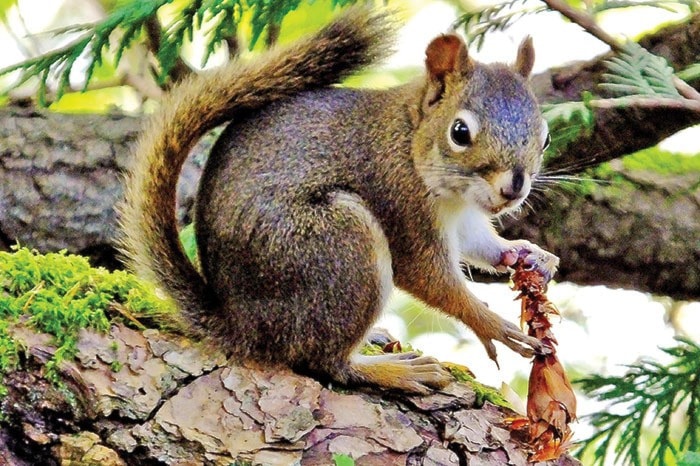Pop quiz: What’s wild and red, barks, and is named after Canada’s Hudson Bay?
Answer: Our small, wild Red Squirrel (Tamiasciurus hudsonicus) – the Island’s only squirrel native. In 1771, the species was first catalogued by Johann Erxleben near Hudson Bay, thus “hudsonicus.” One of the tree squirrels, its clan includes the loveable flying squirrel.
This little charmer barks at intruders to protect its centralized cache of conifer cones. In autumn, the “red” stores great quantities of cones, from which it extracts the nutty seed, dropping the scales into piles called “middens.”
Predominantly granivores, they also dine on spruce buds and needles, mushrooms, poplar buds and catkins, bearberry flowers and berries – even bird eggs.
Distinguished by reddish fur on top and a pale underbelly (venter), this pretty little chipmunk-sized rodent also sports a distinctive white ring circling the eyes.
Recently, the native “red” has had to defend its territory against the Gray Squirrel (Sciurus carolinensis), an introduced species that continues a troubling northward expansion on Vancouver Island.
Should you spot one, it’s likely you’ll see it again near the same area, as this diurnal mammal defends a year-round exclusive territory.
Weighing a mere 140-250 g, our native “red” – with a lifespan of only two to eight years – must ward off prey, including owls, hawks, crows, martens, weasels and coyotes.
The species – also known as pine squirrel or barking squirrel – is protected as a furbearer under the B.C. Wildlife Act (yellow-listed), although elsewhere, they are still trapped for fur.
E-mail Christine at: wildernesswest@shaw.ca.
